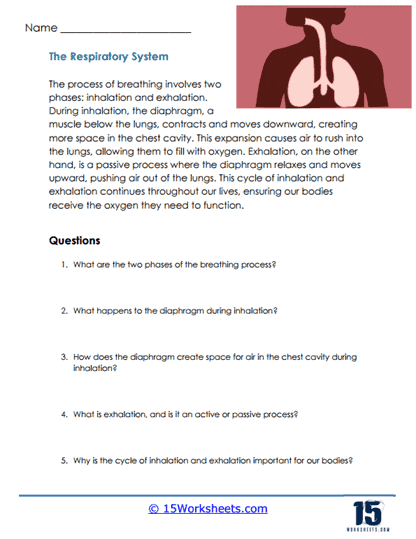Mechanics of the Respiratory System

Worksheet Description
This worksheet delves into the mechanics of the respiratory system, particularly focusing on the two primary phases of the breathing process: inhalation and exhalation. It sheds light on the pivotal role of the diaphragm, a muscle situated below the lungs, in facilitating these processes. The sheet elucidates how, during inhalation, the diaphragm contracts and moves downward, making space for air to enter the lungs, while during exhalation, the diaphragm relaxes and ascends, allowing air to be expelled. Complementing this detailed explanation are questions designed to assess a student’s grasp of the subject matter.
To effectively work through this worksheet, students should start by carefully reading and understanding the detailed description of the breathing process, ensuring they comprehend the contrasting actions of the diaphragm during inhalation and exhalation. After internalizing this information, they should then methodically address each question, referring back to the primary text as needed to ensure accuracy in their responses. It’s beneficial to take a moment to reflect on the answers, considering the broader implications of the breathing cycle for human health and vitality. A subsequent review of the answers against the main content can further solidify understanding and rectify any misconceptions.
The worksheet’s core objective is to impart students with an in-depth understanding of the mechanics underpinning the breathing process, emphasizing the essential role of the diaphragm. By illustrating the contrasting yet harmonious phases of inhalation and exhalation, the worksheet aims to highlight the continuous cycle essential for life. Students are encouraged to grasp not only the basic concepts but also the significance of these processes in ensuring our bodies receive the requisite oxygen for optimal functioning. Through the series of structured questions, the worksheet further challenges students to reflect on and apply their acquired knowledge in a meaningful way.
